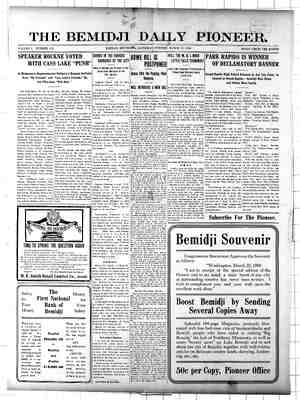Bemidji Daily Pioneer Newspaper, March 27, 1909, Page 22
You have reached the hourly page view limit. Unlock higher limit to our entire archive!
Subscribers enjoy higher page view limit, downloads, and exclusive features.
{ | BEMIDJI, BELTRAMI COUNTY AND NORTHERN MINNESOTA. We call attention, for the third time in this edition of The Pioneer, to the abundance and nutriment of the tame and wild grasses which thrive in this portion of Minnesota, in order that we may convince the pros- pective dairyman and stockraiser of the possibilities open to him as to these two industries. The following official excerpts denote the availability of this portion of the state as a dairving and stockraising center, and ap- pended will be found ofticial reports from the state immigration office. They offer food for reflection to the prospective home- seeker, From A. J. McGuire, superintendent of the North-Kast Experimental farm at Grand Rapids, and who is a recognized authority on dairving., we have the following: “The state 1895 passed a Lill providing for a dairying experiment station for Northeastern Minnesota. Grand Rapids was chosen for the location. A Minneapoas firm in sympathy with - the movement later donated 80 acres, making 155 acres in all. “The Kxperiment Farm was opened dur- ing the spring of 1896 under .supervision of Warren W. Pendergast, a graduate of the legislature of school and college of agriculture of the University of Minnesota. The state establishcd toae Experiment Farm in order {o determine the dairying possiblities of the country., and to work out a system of farming that would be practical and most profitable under the natural conditions peculiar to Northeastern Minnesota. “The strongest endorsement of the agri- cultural merits of the county i in the orowth of clover. This wonderful plant, so difficult to grow in some sections of the siate, finds a native habitation in North- central Minnesota, and especially Beltrami county, and vields as high as four tons of cured hay per acre at a single cutting. A twelve acre field on the Experiment Farm that had only its natural fertility, having mnever been manured, vielded 3% fong of cured hay per acre in a cutting in 1906, and the following year (1907), 3.65 fons per acre. When it is considered that two tons of hay per acre is considered a large vield, the possible prodigality of milk and butter production is indeed won- derful. “The great value of clover is not so much in its production of feed as in its effect upon the soil. Clover leaves the soil richer, having the power to draw an element of fertility (nitrogen) from the air, and leaves it in the soil stored in its abundant roots. “put thig is another story. With the ex- ception of corn safely maturing, every crop that is essential to successful dairying and farming has been grown on the Experiment Farm with good results. While corn as yet may not be grown successfully for grain, it produces excellent fodder, and for this purpose from ten to fifteen acres is grown on the Experiment Farm every vear. Tt is used for both fodder and ensilage, vield- ing from 5 to 8 tons per acre of cured fod- der, and from 10 to 15 tons per acre of en silage. A “A1l kinds of root crops find the soil and climatic conditions of Northeastern Min- nesota especially favorable to their growth. Potatoes is the great money-making crop for the farmer of few acres under cultiva- {ion. Stock roots, such as carrots, mangles, and rutabagas vield from 12 to 20 tons per acre. Roots may be made to take the | place of grain to a large extent in feeding live stock in the winter, and their food value in comparison with high priced grain makes them a valuable crop. “There are two very good reasons for advocating dairying in a country so favor- able to that industry as Northeastern Min- nesota, The dairy cow is the most pro- ductive of all farm animals, and in dairying less of the soil fertility is removed than North-central Minnesota, through the per- sistent and able efforts of Mr. McGuire, now in charge of the station, and all of them, having sufficient patronage, paid over 27 cents per pound for butter fat during the past year.” To indicate the value of the dairy pro- ducts of this portion of the state, The Pioneer need but say that of all the creameries in Minnesota their product is A. ]. McGUIRE, Superintendent of Northeast Experiment Farm, who has done much for the Dairying and Farming Interests of Northern Minnesota. in any other branch of agriculture. The demonstration of this may be seen in the fact that the dairy farmers are the most prosperous the world over, whether in Min- nesota, Vermont or Denmark. “In this section of the state where the acres under -cultivation must necessarily be few, what crops are grown should be made the best possible use of, and that is in feeding. Feeding on the farm, and sell- ing a finished product, and butter is the highest finished product of the farm. The creameries that "have been established in annually contracted for by the merchants of New York, Philadelphia, Baltimore and other eastern centers of importance, thus securing the highest market price for every pound of butter that is shipped. In a certain town of this section of the state loeated in a community where the farmers have gone into dairying, the bank paid out over $80,000.00 for cream checks; over $7,000.00 a month during 1907. In this same town five years ago, before the farmers had a creamery, and made a busi- ness of dairying, they did not receive a dollar




